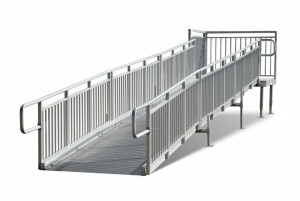It can be challenging to keep up with ADA ramp regulations in California. But if you want to be in compliance – whether you have a new building, you’re in a building that’s several decades old, or anything in between – you have to be on top of all federal, as well as state, requirements. REDD Team can make it a lot easier by providing you with a ramp that meets all governmental regulations.
Why Choose REDD Team?
 REDD Team designs and manufactures ramps and other accessibility products, such as stairs and walkways, with safety and quality in mind. Everything we offer is compliant with all ADA regulations, and built to last.
REDD Team designs and manufactures ramps and other accessibility products, such as stairs and walkways, with safety and quality in mind. Everything we offer is compliant with all ADA regulations, and built to last.
Our Universal Wheelchair Ramp System is compatible with both modular and site-built facilities. Made of strong, durable aluminum, our ramps are always safe to touch and provide a non-slip surface. Anyone who uses it can do so with complete confidence, regardless of the weather conditions. REDD Team ramps are made from 6000 series aluminum and fortified with 6063-T5, 6063-T6 or 6061-T6 alloys, the strongest and toughest alloys available.
What are Some ADA Ramp Requirements in California?
The following are just some of the requirements you’ll need to satisfy in order to make sure your ramps are in total compliance with all ADA mandates. It will be very important that you talk to a local building inspector to learn more.
- All landings at the base of a wheelchair ramp have to extend six feet past the edge, and extend in the direction of travel.
- Landings at the top of the ramp have to be at least five feet wide.
- Ramps that exceed 30 feet in length have to sit on a resting platform.
- If a ramp landing has a manual door or a swinging gate, it must comply with California Building Code regulations governing maneuvering clearance.
- Ramps cannot exceed a slope ratio of 1:12. This is equivalent to one foot or ramp, or 4.8 degrees of slope, for every inch of rise that exists.
- All ramps must have protection on the edges to eliminate the risk of slipping.
- All surfaces of platforms and ramps must be designed to prevent water accumulation. They must also be slip-resistant.
- Handrails are required on ramps that either project more than six feet in a horizontal direction or have a rise steeper than six inches. These handrails must be between 34 inches and 38 inches high.
At REDD Team, we have a team of experts who are extremely knowledgeable in all facets of the ADA in the area of accessibility. We will be happy to answer any questions you may have, and design a custom ramp that meets your exact needs.
Never Ignore ADA Requirements
California is one of the most conscientious states in the country when it comes to ADA compliance. However, it is also one of the most litigious. More than 20,000 ADA lawsuits have been filed in the state since 1992, and these lawsuits cost California businesses more than $20 million each year. They can be very difficult to defend, and usually lead to payouts of $4,000 to $6,000 at a minimum.
Don’t let your business suffer because you weren’t aware of ADA ramp regulations in California. Let the experts with REDD Team ensure your compliance. Call (800) 648-3696 or contact us online for more information.
